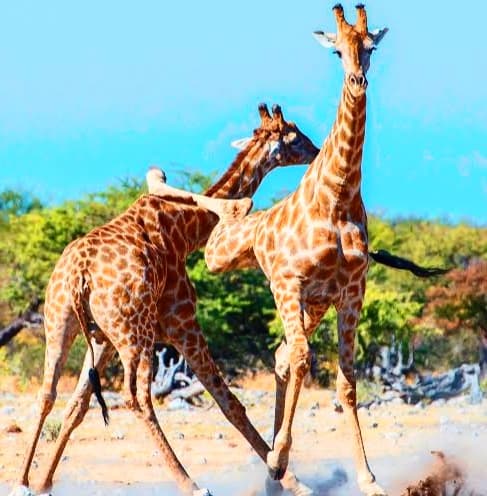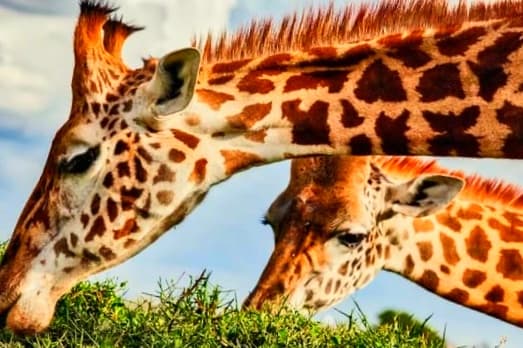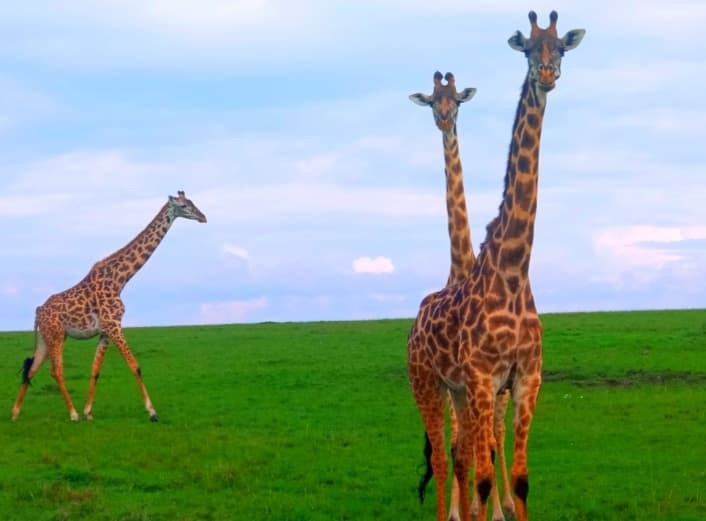I call them Giants, Tallboys and Girls, as tall as a Giraffe they say. Today is the day for the facts about Giraffes.
Despite being fewer than their counterpart giants Elephants. I can almost guarantee you will not go for a game drive in East Africa and miss to see a Giraffe any day.
I suppose they just happen to be friendly or is it because they look down upon us? The Giraffe population has fallen by 40% since 1990.
According to humane Society International, research of giraffe trade into the U.S. conducted as part of a petition revealed that nearly 40,000 giraffe parts and products have been imported into the U.S over the last decade.
These parts are thought to represent nearly 4,000 individual giraffes, indicating that the U.S. is a substantial market for trade in giraffes.
If this continues, we may as well see to it, extinction of this Beautiful Giants (Giraffes).
Without much ado, let’s delve in and see the facts about giraffes.
17.) Facts about Giraffes Tongue.

This is one of the most important organs in any living creature but it is even more important when it comes to Giraffes.
Boasting of 45-50 Centimeter long. It helps the Giraffes in feeding. As much as they are the tallest animals in the world, they still need a long Tongue to help them reach further.
These Giants have a blackish tongue, even scientists have never known why it would have such a tongue, however, there is a theory that makes sense.
The tongue is blackish to help prevent it from Sunburn since the Giraffes spend most of their time eating, chopping out their tongue out at the scorching sun rays of African Continent where they are found in their Natural Habitat.
The Male Giraffes use the tongue to taste the female urine to know if it is on heat.
16.) The lifeSpan of a Giraffe.
Giraffes live a shorter lifespan compared to other Large terrestrial Mammals. There is no recorded life expectancy but it is believed both Male (Bulls) and Female (Cows) have a life expectancy of around 25 Years in the wild. Just like humans, the cows ( Females) seem to live longer than the bulls.
15.) Facts about Giraffes Neck.
They have the longest neck which helps them reach for the freshest leaves in the jungle, we can say they feast on first-class since no competition but them.
Some grow a long neck of up to 7 Feet. Apart from using their long Necks for feeding. They use them for fighting the longer and thicker the neck the more chances of the Bull winning a fight which stands a chance to mate with any female of choice.
The neck is also used for spotting enemies from a distance and it has 7 vertebrates just like humans.
14.) Facts About Giraffes Skin.
Their skin is undoubtedly beautiful, this is both a blessing and a curse at the same time, one of the reasons the giraffes are decreasing is poaching for their skin.
However, the skin is a blessing as well, it is one of the best camouflages, it blends so well with the African soil, confusing the potential predators. Each skin pattern is believed to be different, just like the human palm.
13.) Facts About Giraffes Heart.
Giraffes have the biggest heart on earth, weighing around 11 Kilogram and 2 feet Long, pumping blood of 60 litres a minute around the gigantic body with a pressure twice as human beings. I wonder since they have such a big heart if they are kind.
12.) Facts About Giraffes Kick.

It is said, just one well-executed kick can kill a lion instantly. It is that powerful, their feet (Ungulates) measure up to 30 Centimeters across, equaling and resembling a big food plate.
Their long-Muscled legs enable them to run 60Kilometers Per Hour but on a short distance. However, they can do up to 16 kilometres per hour in a long distance.
11.) How Giraffe Communicate.
According to Discover Wildlife, the Giraffes were believed to not make a single noise or even grunt. However, they who make or communicate in low tones that the human cannot be able to comprehend.
A recent study was done and they found out that they grunt at night though in low tones but the human can hear the grunting.
10.) How do they drink water?

Thanks to the leaves they consume in those acacia and Mimosa Trees, most have water and the Giraffe can go without water more than a camel.
However, it doesn`t mean it can go without water entirely. When they go for it is never that easy as their necks reaching out for the water on the ground is such a hustle.
They weirdly stretch their legs apart to become shorter for the long neck be able to reach the water service.
9.) Just How Tall are Giraffes?
The tallest giraffe ever recorded was about 5.9 Meters almost 6meters taller than some flats in a small ghetto-ish estate in Kenya known as Githurai 45.
They are the tallest mammals on planet earth. Pollination across different flora has been successful thanks to the Giraffes who can reach out to other unreachable plants for pollination.
8.) Facts about Giraffes “Horns”

They are not called and neither are they “Horns” but ossicones. Whereby both the female and males have as opposed to many think only the males have.
However, the female ossicones are shorter and covered by hair. The male Giraffes use the “horns” for fighting with the fellow male while competing for a female. Did I mention they are the only animals born with “Horns” known as Ossicones?
7.) Facts about Giraffe Calves.
The Giraffe Calf Can Stand and walk within the first one hour after birth and be able to sample what to feed within a week.
As much as the Giraffes may defend their calves many never make it to adulthood due to Predators like Lion, hyenas, leopards, cheetahs and wild dogs.
6.) Facts about Giraffe Diet.
These guys eat almost 45 Kilograms of vegetation in a day. They continuously eat and only sleep a few hours. Sleeping while standing is no myth to them.
Even giving birth, they do it while standing so the calf first greetings after birth is a hard fall of six feet long.
They mostly feed on those acacia and mimosa trees; they are picky since they are the only competition when it comes to food.
5.) 50 % of Male Giraffes are Gay/Bisexual.
It is very common for the male giraffes to copulate with each other especially if they don`t have their females on sight.
According to DW and I quote “Among giraffes, there’s more same-sex than opposite-sex activity. Studies say gay sex accounts for more than 90 per cent of all observed sexual activity in giraffes. And they don’t just get straight to business. Male giraffes know how to flirt, first necking with each other – that is, gently rubbing their necks along the other’s body. This foreplay can last for up to an hour.” Now be the judge. Again, this may have contributed to their significant population decrease.
Facts About Giraffe Species.
According to GCT and Partners after long-term research, they identified four distinct species of Giraffe in Africa, they are namely-: Masai Giraffe, Southern, Northern Giraffe and Reticulated giraffe with other several subspecies.
Only 3 are found in Kenya. Namely Reticulated Giraffe, Maasai Giraffe and Rothschild under Nubian.
4.) Facts about Maasai Giraffes.

Also known as Kilimanjaro Giraffe. The Masai Giraffe is the most populated species of the giraffe, native to East Africa. Mostly found in South and central parts of Kenya and Tanzania.
You can distinguish it from the other Giraffe species since it has irregular, star-like blotches that extend to the hooves, a median forehead lump mostly found in bulls.
According to National Geographic, there are only 35,000 Maasai Giraffes left in the wild. They are poached mostly for their meat, skin and their tail.
3.) Facts about Northern Giraffes.

There are 3subspecies Namely Nubian Giraffe, West African Giraffe and Kordofan giraffe. A well-known subspecies of Northern Giraffe is the Rothschild (Under Nubian Giraffe).
They all have a major distinctive measure from the other Giraffe species. They do not have spot markings on their legs
2.) Facts about Southern Giraffes.
There are two subspecies of Southern Giraffe Namely Angolan giraffe and southern African Giraffe. According to GCT, the Angolian Giraffes are relatively light in colour.
In northwest Namibia, where it is particularly arid, they can be almost colourless. They have large, uneven and irregularly notched light brown patches.
Their patches are surrounded by a pale cream colour, and their lower legs are randomly speckled with uneven spots.
While the Southern African Giraffe has star-shaped patches in various shades of brown, surrounded by a light tan colour. Their lower legs are randomly speckled with uneven spots.
1.) The reticulated Giraffe.

The reticulated giraffe is also known as the Somali giraffe and was added to the list of the endangered species in 2018 by IUCN Red List due to the declining population rate.
The Reticulated Giraffes are found in Eastern and Northern side of Kenya and southern part of both Somalia and Ethiopia.
These Giraffes are easily identifiable. They have rich orange-brown patches that are clearly defined by a network of striking white lines. Which continue the entire length of their legs.
In Kenya, we have the only hotel in the world where you can wine and dine with the Giraffes freely.









